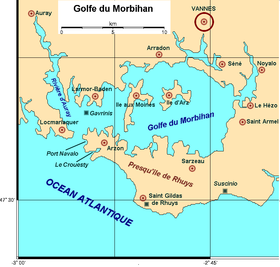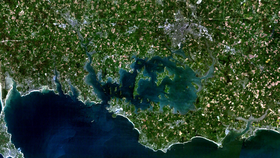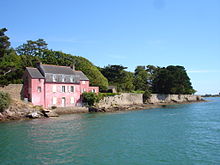Gulf of Morbihan
See also Golfe du Morbihan (Kerguelen)




The Gulf of Morbihan is a natural harbour on the coast of the Département of Morbihan in the south of Brittany, France. This English name is taken from the French version: le golfe du Morbihan. It is more accurately called 'the Morbihan' directly from its Breton name which is Ar Morbihan, meaning 'the little sea' (Compare the Welsh y môr bychan), as opposed to the Atlantic Ocean outside, (Ar Mor Braz). Legend says that there are as many islands in the Gulf as there are days of the year. However, this is untrue and the gulf has about 40, depending on the tide. Many islands are private property, except l'Île-aux-Moines and l'Île d'Arz.
The area around the gulf features an extraordinary range of megalithic monuments. There are passage dolmens, stepped pyramids with underground dolmen chambers, stone circles, and giant menhirs, among others. The site best known to outsiders is Carnac, where remains of a dozen rows of huge standing stones run for over ten kilometers. The passage grave of Gavrinis, on a small island in the Gulf, is one of the most important such sites in Europe. Some of the ruins have been dated to at least 3300 BC — 200 years older than England's Stonehenge.
Geography
Tides and currents
The gulf is sheltered from the Atlantic Ocean by the peninsula of Rhuys, but there is a 1km long gap between Port-Navalo (in the commune of Arzon) and Kerpenhir (commune of Locmariaquer). Because of this gap, there are strong tidal currents. At this gap, water speeds can reach up to 5 knots.
Communes located along the gulf
- Locmariaquer
- Auray
- Plougoumelen
- Le Bono
- Baden
- Larmor-Baden
- Arradon
- Île-aux-Moines
- Île-d'Arz
- Vannes
- Séné
- Theix
- Noyalo
- Le Hézo
- Saint-Armel
- Sarzeau
- Saint-Gildas-de-Rhuys
- Arzon
